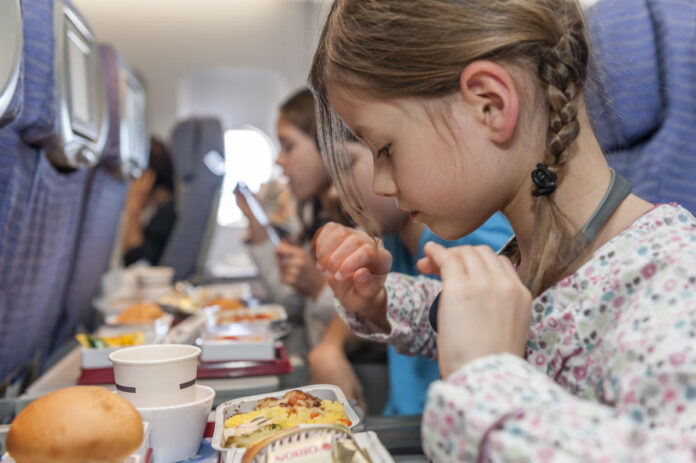When it comes to air travel, plane food safety is probably not the top concern for most passengers. However, given the unique challenges involved in serving hundreds of meals in a confined space with recycled air, it’s fair to ask whether airplane food is really safe to eat. The short answer is yes — generally, it is. But there are certain precautions to keep in mind to minimize potential risks.
“Plane food is generally safe and is regulated by the [U.S. Food and Drug Administration],” Jen Dunphy, a doctor in public health, told Yahoo Health. “This means there are inspections as to how the food is sourced, prepared and stored.”
However, as with any industry, no system is flawless. Incidents like the Delta Air Lines flight from Detroit to Amsterdam in July, which had to make an emergency landing due to “spoiled food” that sickened passengers, serve as a reminder that things can occasionally go wrong.
Here’s what you need to know about food safety before your next flight.
Avoid raw food — or anything that’s kept cold
One of the primary concerns with food safety is the potential for contamination. While high-altitude travel presents a unique environment, the food-handling processes are generally similar to those on the ground. Still, Dunphy said there are specific risks to be aware of when consuming food on a plane.
“Overall, inspections regarding plane food preparation do not occur frequently,” she said. “Operational changes and environmental conditions can also lead to issues with how the food is stored, leading to food poisoning incidents.”
Foods that require refrigeration, like dairy products or cold seafood, may not always be stored at the correct temperature throughout a long flight, increasing the risk of bacterial growth.
“To mitigate personal exposure to food that may make you ill, I advise avoiding raw seafood and undercooked food on planes, as well as anything that needs to be kept cold, such as a shrimp cocktail,” said Dunphy.
For those concerned about germs, bringing your own prepackaged snacks or meals bought inside the terminal can be a safer alternative.
Best to avoid spicy or fried foods
Paul Janowicz, a pilot for Delta Air Lines, recently told Well+Good that spicy foods often cause irritation during the flight.
“Generally our menus onboard are very mild, but I would not pack any snacks that might have spice involved as it may cause stomach discomfort in-flight,” he said.
The same goes for fried food, which “usually has higher sodium involved, which dehydrates the body and can also cause symptoms like gas and bloating,” said Janowicz.
Think twice about chicken or steak
A flight attendant recently shared with BuzzFeed a tip for travelers: steer clear of steaks when flying, largely due to how they’re prepared onboard.
“The ovens are only so big, and there is only so much food that can fit in it,” it was explained. “If you are particular about how your steak should be prepared, don’t eat it.”
Meats in general are a riskier choice in the air, Darin Detwiler, an associate teaching professor of food policy at Northeastern University, told Food & Wine. Chicken can be particularly tricky.
“It’s tough to tell if chicken is bad just from looking at it,” he said, adding that sauces and flavoring can easily mask any off smells or tastes. He emphasized that the safest way to avoid foodborne illness from chicken is to ensure with a food thermometer that it’s fully cooked — something most passengers aren’t carrying on a flight.
For that reason, Detwiler suggests that it might be best to skip chicken on planes altogether and opt for pasta instead.
What about water and ice?
There are often concerns about the safety of airplane water, particularly on international flights. Dunphy clarified that the risk is relatively low when flying domestically in the U.S.
“Drinking tap water or ice in the United States should be fine,” she told Yahoo Health. “However, if a plane is coming from a foreign country known for having contaminated water, such as Mexico, you should avoid ice and tap water — bottled water is OK — because the plane may source tap water from the country it is departing from.”
In 2011, the U.S. government introduced the Aircraft Drinking Water Rule, requiring airlines to regularly test their water supplies for harmful bacteria. However, a 2019 Airline Water Study evaluated water quality on 11 major and 12 regional airlines, examining factors like the presence of E. coli or coliform bacteria, and found that Alaska Airlines and Allegiant Air offered the safest water, while JetBlue and Spirit Air ranked at the bottom.
According to Insider, the study raised concerns about a possible “lack of enforcement” from the Environmental Protection Agency, which has issued few penalties in recent years.
Flight attendant Kat Kamalani shared a viral TikTok video in 2021 offering a simple rule: “Never consume any liquid that is not in a can or a bottle,” explaining that airplane water tanks are “never cleaned and they are disgusting.”
Given that water tanks and pipes are “rarely cleaned unless they are broken,” Kamalani said even flight attendants tend to avoid drinking coffee or tea on planes.
Rats on a plane?
Concerns about possible rodent infestations — like those that led to the grounding of SriLanken Airlines and India Air flights earlier this year — can understandably cause anxiety among passengers.
However, Dunphy reassures that rats should not be a significant worry for travelers. Instances of rodents being found near airplane food are typically rare and swiftly handled by airline staff and regulatory authorities.
“Rodents on planes are exceedingly rare and should not be a concern to the majority of airline patrons,” she said. “Any reports of this occurring are likely freak incidents that will be thoroughly investigated. Additional protective measures will likely be put in place to prevent even rare incidents of reoccurrence.”

